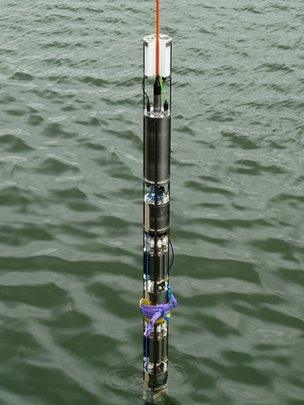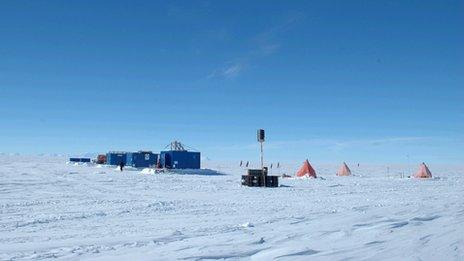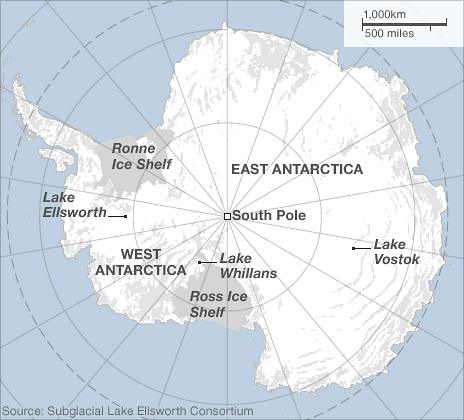Drill kit begins journey to Antarctica's Lake Ellsworth
- Published

Avoiding contamination is a key element of the British drilling project
A daring project to explore an ancient lake hidden beneath the Antarctic ice moves closer to reality this weekend.
A huge load of essential equipment is starting the long journey by ship from the UK to the far South.
Probes to delve into the pitch-black waters of remote Lake Ellsworth are packed for one of the most difficult science missions of recent years.
Engineers raced to sterilise thousands of components to avoid any risk of contamination in the search for life.
The lake lies under an ice-sheet nearly two miles thick and is believed to be totally pristine, having remained isolated for possibly half a million years.
No one can predict what may be found, but some species of microbes are considered likely - which would provide an astonishing example of the adaptability of life to incredibly hostile environments
A Russian project that drilled into Lake Vostok - much larger and deeper than Lake Ellsworth - collected water samples last January but questions remain about the sterility of the equipment and the bore-hole.
Avoiding contamination is a key element of the British project so the drilling and sampling will be undertaken in conditions considered cleaner than those required in a typical surgery.
The mission's success will depend on a combination of high-technology, innovative design and true grit in a region of Antarctica notorious for its freezing weather and near-constant winds.
A first batch of equipment was delivered to the lake site last year by a tractor-train that traversed an icy terrain scarred by crevasses. The gear was then "winterised" and left tor use in the coming months.
The load being included the pump that will drive a hot-water drill - the aim is to blast a hole through the ice not with a standard drill-bit but with the heat and pressure of water at 90C (194F).
The water itself will be melted from surrounding ice and then passed through a series of filters and ultra-violet systems to ensure that it is as sterile as possible - that equipment is on its way now.
The first stage of the operation will involve engineers arriving at the site in early November to activate the winterised equipment and start assembling the camp and key components.

Lake Ellsworth was chosen in part for its relative accessibility
Another tractor-train will deliver the heaviest of the gear including the probes that will sample water and extract a core of lake sediment.
The science team is due in early December and the schedule calls for the actual drilling - a five day process - to start later that month.
Once the bore-hole is complete, there will be just 24 hours before it refreezes and the sampling must all take place within that short period. The first samples are expected to reach the surface in the middle of December.
The chief scientist behind the project is Prof Martin Siegert of Bristol University, who was involved in the first discoveries of lakes in Antarctica and will be at the lake site for the operation.
He describes this mission as "one of the most important and challenging ever conducted in polar scientific exploration".
"We first thought about exploring sub-glacial lakes 16 years ago," he says, "and now we are finally on the cusp of launching our plans and turning dreams of this exploration into reality.
"While the journey getting to this point has been hard we realise we are still only at the beginning."
Much of the preparation of the equipment has been carried out by staff at the British Antarctic Survey in Cambridge and the National Oceanography Centre in Southampton.
In one test, the water sampling probe - the result of three years of design and development - was carefully lowered over the dockside to check its controls.
With the instruments powered up and calibrated, the aim was to check the device could gather water samples at different depths, while taking other readings and capturing HD video.
A minor communications problem was later fixed and a valve on one of the 24 sampling bottles stuck but otherwise the sensors and cameras worked fine.
The test took place on Friday 13 July.
But project manager Chris Hill said: "Despite this test being on such an ominous date (a brave move if ever there was one), I'm pleased to report that the test was a great success. "
Meanwhile the second of the probes - a sediment corer - was put through its paces in a trial at a lake in Austria.
The device has to be able to withstand the extreme conditions of Antarctica but hostile weather of a different kind challenged the team: a thunderstorm struck while the engineers were out on a boat in the middle of the water.
Since then the probes and all the support equipment have been sterilised multiple times: scrubbing with detergent, washing in biocide, bathing in ethanol and then a blast of hydrogen peroxide vapour.
After visiting the team several times this year, it is clear that they have endeavoured to think through every potential problem and have learned lessons from previous expeditions.
For example, an earlier attempt to use a hot water drill in Antarctica failed when the hose, made up of 400m sections, broke apart under the weight of the water. This time, the hose is a single length.
According to Prof Siegert, there are risks with only having one hose and one boiler. On the other hand, there will be four pumps when only two are needed and the stores of fuel and many components have been doubled-up.
But when pressed on the chances of success - of surviving the cold, of getting everything to work properly and of retrieving uncontaminated samples - Prof Siegert and the rest of the team tend to give the same answer.
"Let's not forget that we're dealing with Antarctica," they say. Antarctica.
That one word conveys so much: extreme isolation, incredibly forbidding conditions and an unmatched ability to be totally unpredictable.
The Lake Ellsworth Consortium is funded by the Natural Environment Research Council (Nerc).
Martin Siegert is featured on The Life Scientific on BBC Radio 4 on Tuesday August 21 at 9am and 9.30pm

Russian and US teams are targeting Lakes Vostok and Whillans respectively
- Published1 May 2012
- Published16 February 2012
- Published16 January 2012
- Published11 October 2011